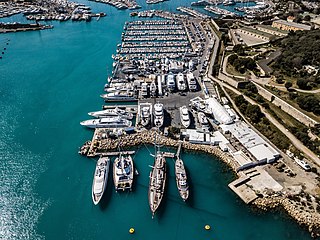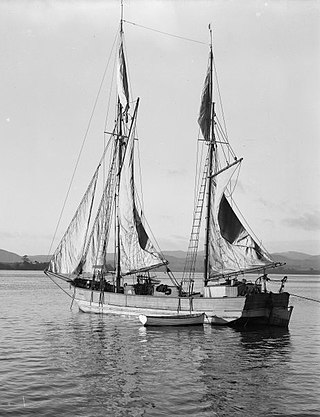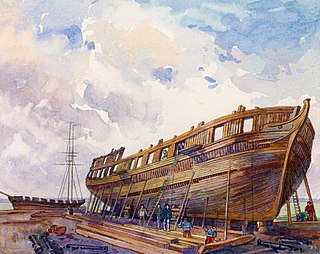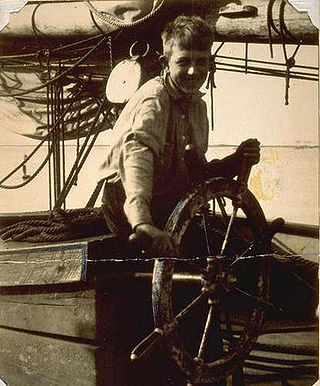
Barge often refers to a flat-bottomed inland waterway vessel which does not have its own means of mechanical propulsion. The first modern barges were pulled by tugs, but on inland waterways, most are pushed by pusher boats, or other vessels. The term barge has a rich history, and therefore there are many other types of barges.

A shipyard, also called a dockyard or boatyard, is a place where ships are built and repaired. These can be yachts, military vessels, cruise liners or other cargo or passenger ships. Compared to shipyards, which are sometimes more involved with original construction, dockyards are sometimes more linked with maintenance and basing activities. The terms are routinely used interchangeably, in part because the evolution of dockyards and shipyards has often caused them to change or merge roles.

A scow is a smaller type of barge. Some scows are rigged as sailing scows. In the 19th and early 20th centuries, scows carried cargo in coastal waters and inland waterways, having an advantage for navigating shallow water or small harbours. Scows were in common use in the American Great Lakes and other parts of the U.S., Canada, southern England, and New Zealand. In modern times their main purpose is for recreation and racing.

The Naval Shipyards were naval shipbuilding facilities used by the Provincial Marine and the Royal Navy in York, Upper Canada. The naval shipyards were ordered by the Lieutenant Governor of Upper Canada John Graves Simcoe in 1793, and were opened in 1798.

The Minto Sailing Dinghy is a sailing dinghy first produced commercially in the early 1960 and still in production.

The Battle of Fort Brooke was a minor engagement fought October 16–18, 1863 in and around Tampa, Florida during the American Civil War. The most important outcome of the action was the destruction of two Confederate blockade runners which had been hidden upstream on the Hillsborough River.
Nobiskrug is a shipyard located on the Eider River in Rendsburg, Germany, specialized in building innovative, custom-made luxury superyachts.

The first USS Wanderer was a high-speed schooner originally built for pleasure. It was used in 1858 to illegally import slaves from Africa. It was seized for service with the United States Navy during the American Civil War. In U.S. Navy service from 1861 to 1865, and under outright U.S. Navy ownership from 1863 to 1865, she was used by the Union Navy as a gunboat, as a tender, and as a hospital ship. She was decommissioned, put into merchant use, and lost off Cuba in 1871.

John Faunce Leavitt (1905–1974) was a well-known shipbuilder, writer on maritime subjects, painter of marine canvases, and curator of Mystic Seaport in Mystic, Connecticut.

George Lawley & Son was a shipbuilding firm operating in Massachusetts from 1866 to 1945. It began in Scituate, then moved to Boston. After founder George Lawley (1823–1915) retired in 1890, his son, grandson and great-grandson upheld the business, which continued until 1945. Of the hundreds of ships built by the Lawleys, highlights include the yachts Puritan and Mayflower, respective winners of the 1885 and 1886 America's Cup.
Henry B. Nevins Incorporated was wooden-hull yacht builder in City Island, New York founded in 1907 by Henry B. Nevins. Nevins was a master yacht builder and author on vessel construction who apprenticed at the island's Charles L. Seabury & Company. Later he purchased the nearby Byles Yard to increase his company's acreage. Henry B. Nevins Inc. built custom sail and motor yachts and racing craft for affluent clients, but also small tugs and barges for commercial customers. Run by a perfectionist, Nevins' company seasoned its own lumber, designed and machined its own fittings, made its own glue, and balanced spars by weighing shavings. As a result, Nevins built more cup-winning yachts than anyone else in the industry.
J.W. Clise was a four master schooner built in 1904 in United States and sailed for both Norwegian and American companies.

Steamboats on the Colorado River operated from the river mouth at the Colorado River Delta on the Gulf of California in Mexico, up to the Virgin River on the Lower Colorado River Valley in the Southwestern United States from 1852 until 1909, when the construction of the Laguna Dam was completed. The shallow draft paddle steamers were found to be the most economical way to ship goods between the Pacific Ocean ports and settlements and mines along the lower river, putting in at landings in Sonora state, Baja California Territory, California state, Arizona Territory, New Mexico Territory, and Nevada state. They remained the primary means of transportation of freight until the advent of the more economical railroads began cutting away at their business from 1878 when the first line entered Arizona Territory.

C. & R. Poillon was a 19th-century shipyard company in Brooklyn, New York. The company employed over 300 workers, owned several shipyards, and launched 175 vessels. The company was one of the best known clipper ship firms and the last of the wooden hulled boat builders in New York.
This glossary of nautical terms is an alphabetical listing of terms and expressions connected with ships, shipping, seamanship and navigation on water. Some remain current, while many date from the 17th to 19th centuries. The word nautical derives from the Latin nauticus, from Greek nautikos, from nautēs: "sailor", from naus: "ship".

The Mary E. Fish was a 19th-century Sandy Hook pilot boat, built at the Edward F. Williams shipyard of Greenpoint, Brooklyn in 1861 for Richard Brown and the New York Pilots. She was built to replace the Mary Taylor. The Fish was hit and sank by the schooner Frank Harrington in 1885 and replaced by the David Carll.

The Coquette was a 19th-century yacht and pilot boat, built in 1845 by Louis Winde, at the Winde & Clinkard shipyard in Chelsea, Massachusetts for yachtsmen James A. Perkins. Her design was based on a model by shipbuilder Dennison J. Lawlor. The Coquette was a good example of an early American yacht with a clipper bow. As a yacht, she won the attention for outsailing the larger New York yacht Maria at the second New York Yacht Club regatta in 1846. Perkins sold the Coquette to the Boston Pilots' Association for pilot service in 1848. She continued as a pilot boat until 1867 when she was sold as a Blackbirder to be used on the African coast.
This glossary defines the various types of ships and accessory watercraft that have been used in service of the United States. Such service is mainly defined as military vessels used in the United States Navy and United States Coast Guard, as well as the defunct, incorporated, or renamed institutions such as the United States Revenue Cutter Service. Service of the United States can also be defined in this context as special government missions in the form of expeditions, such as the Wilkes Expedition or the North Pacific Exploring and Surveying Expedition. The scope of the glossary encompasses both the "Old Navy" of the United States, from its beginnings as the "Continental Navy", through the "New Navy" and up to modern day. The watercraft included in the glossary are derived from United States ships with logbooks published by the National Archives and Records Administration.

Astoria Marine Construction (AMCCO) was founded as Astoria Shipbuilding by Joe Dyer is 1929 in Jeffers Gardens of Astoria, Oregon. Joe Dyer's father was a pioneer of early Astoria and operated a family sawmill. Joe Dyer started by building wooden fishing boats at his shipyard. Then added wooden pleasure craft to his product line. Joe Dyer designed and built Columbia River One Design (CROD) boats and boats for the United States Navy. The shipyard was on the east bank of the Lewis and Clark River and the Jeffers Slough. Due to its historical importance the site is on the National Register of Historic Places in Clatsop County, Oregon. Astoria Marine Construction shipyard closed in 2013.















